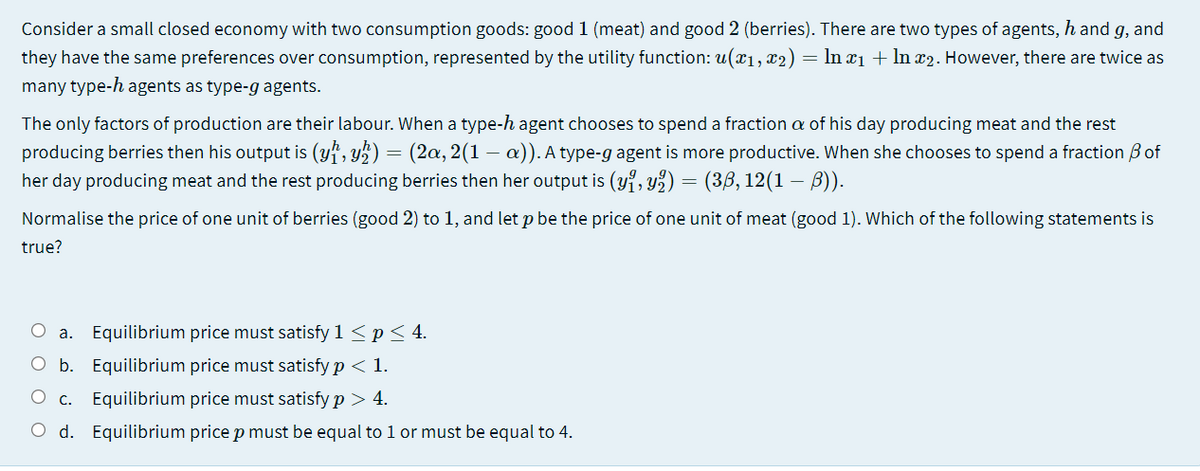Consider a small closed economy with two consumption goods: good 1 (meat) and good 2 (berries). There are two types of agents, h and g, and they have the same preferences over consumption, represented by the utility function: u(x1, x2) = lIn ¤1 + In x2. However, there are twice as many type-h agents as type-g agents. The only factors of production are their labour. When a type-h agent chooses to spend a fraction a of his day producing meat and the rest producing berries then his output is (yf, y5) = her day producing meat and the rest producing berries then her output is (yi, y): (2a, 2(1 – a)). A type-g agent is more productive. When she chooses to spend a fraction B of (3В, 12(1 — В)). Normalise the price of one unit of berries (good 2) to 1, and let p be the price of one unit of meat (good 1). Which of the following statements is true? O a. Equilibrium price must satisfy 1 4. O d. Equilibrium price p must be equal to 1 or must be equal to 4.
Consider a small closed economy with two consumption goods: good 1 (meat) and good 2 (berries). There are two types of agents, h and g, and they have the same preferences over consumption, represented by the utility function: u(x1, x2) = lIn ¤1 + In x2. However, there are twice as many type-h agents as type-g agents. The only factors of production are their labour. When a type-h agent chooses to spend a fraction a of his day producing meat and the rest producing berries then his output is (yf, y5) = her day producing meat and the rest producing berries then her output is (yi, y): (2a, 2(1 – a)). A type-g agent is more productive. When she chooses to spend a fraction B of (3В, 12(1 — В)). Normalise the price of one unit of berries (good 2) to 1, and let p be the price of one unit of meat (good 1). Which of the following statements is true? O a. Equilibrium price must satisfy 1 4. O d. Equilibrium price p must be equal to 1 or must be equal to 4.
Chapter3: Preferences And Utility
Section: Chapter Questions
Problem 3.9P
Related questions
Question
plssolve this ques within 15-20 minutes with clear explantion I'll give you multiple votes

Transcribed Image Text:Consider a small closed economy with two consumption goods: good 1 (meat) and good 2 (berries). There are two types of agents, h and g, and
they have the same preferences over consumption, represented by the utility function: u(x1, x2) = ln xı + In x2. However, there are twice as
many type-h agents as type-g agents.
The only factors of production are their labour. When a type-h agent chooses to spend a fraction a of his day producing meat and the rest
producing berries then his output is (yf, y½) = (2a, 2(1
her day producing meat and the rest producing berries then her output is (yi, y%) = (3,6, 12(1 – B)).
a)). A type-g agent is more productive. When she chooses to spend a fraction B of
Normalise the price of one unit of berries (good 2) to 1, and let p be the price of one unit of meat (good 1). Which of the following statements is
true?
a. Equilibrium price must satisfy 1 <p< 4.
O b. Equilibrium price must satisfy p < 1.
c. Equilibrium price must satisfy p > 4.
O d. Equilibrium price p must be equal to 1 or must be equal to 4.
Expert Solution
This question has been solved!
Explore an expertly crafted, step-by-step solution for a thorough understanding of key concepts.
Step by step
Solved in 2 steps

Knowledge Booster
Learn more about
Need a deep-dive on the concept behind this application? Look no further. Learn more about this topic, economics and related others by exploring similar questions and additional content below.Recommended textbooks for you

